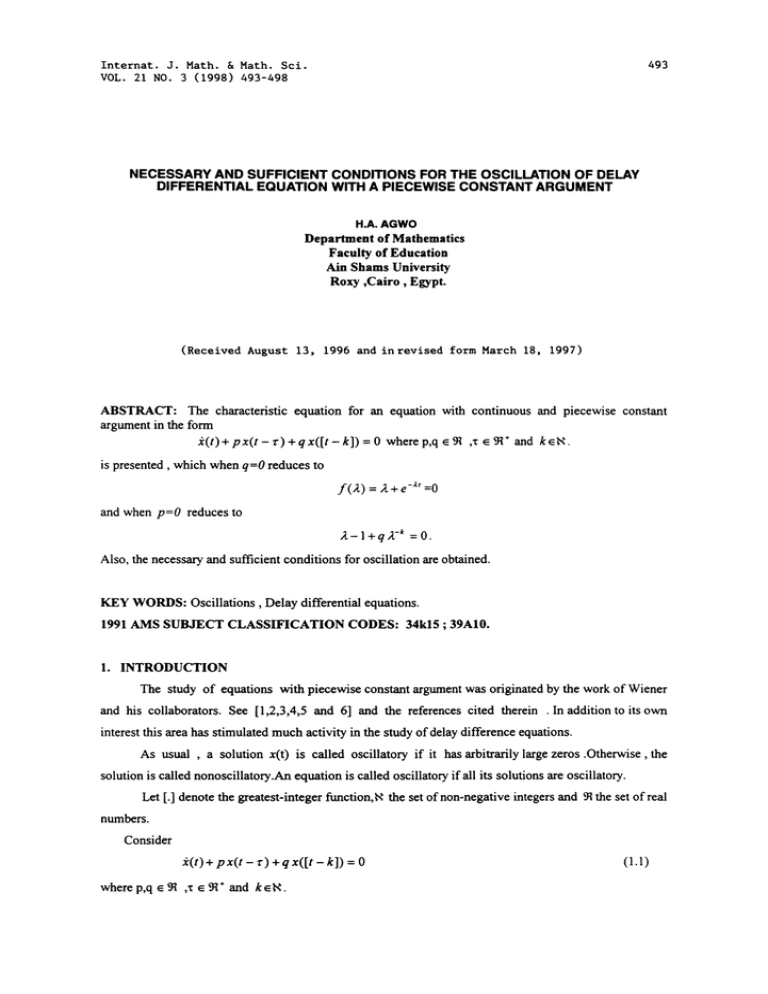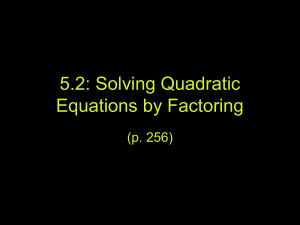NECESSARY AND SUFFICIENT CONDITIONS THE OSCILLATION DELAY DIFFERENTIAL
advertisement

Internat. J. Math. & Math. Sci.
VOL. 21 NO. 3 (1998) 493-498
493
NECESSARY AND SUFFICIENT CONDITIONS FOR THE OSCILLATION OF DELAY
DIFFERENTIAL EQUATION WITH A PIECEWlSE CONSTANT ARGUMENT
H.A. AGWO
Department of Mathematics
Faculty of Education
Ain Shams University
Roxy ,Cairo, Egypt.
(Received August 13, 1996 and in revised form March 18, 1997)
ABSTRACT: The characteristic equation for an equation with continuous and piecewise constant
argument in the form
(t)+px(t-r)+qx([t-k])=O where p,q e9t ,x effl and keN.
is presented, which when q=O reduces to
f (l) A + e -at =0
and when p=O reduces to
l-l+ql-*
=0.
Also, the necessary and sufficient conditions for oscillation are obtained.
KEY WORDS: Oscillations, Delay differential equations.
1991 AMS SUBJECT CLASSIFICATION CODES: 34k15 39A10.
1. INTRODUCTION
The study of equations with piecewise constant argument was originated by the work of Wiener
and his collaborators. See [1,2,3,4,5 and 6] and the references cited therein
In addition to its own
interest this area has stimulated much activity in the study of delay difference equations.
As usual
a solution x(t) is called oscillatory if it has arbitrarily large zeros .Otherwise, the
solution is called nonoscillatory.An equation is called oscillatory if all its solutions are oscillatory.
Let [.] denote the greatest-integer function, N the set of non-negative integers and 9 the set of real
numbers.
Consider
c(t)+ p x(t r) + q x([t k]) 0
where p,q e ffl ,x e R and k
(1.1)
494
H.A. AGWO
By a solution of Eqn.(1.1), we mean a function x which is defined on the set {-k
-1, 0}
[<,oo) and satisfies the following properties:
(a) x is continuous on [-%oo ).
(b) the derivative
exists at each point
(0,oo) with the possible exception of the points eN where
one side derivatives exist.
(c) Eqn.(1.1) is satisfied on each interval [n,n+l) for n
Let
a_ ,a be given real numbers such that
C([-r,0], ) and a_
#(-j) for j <x j-O,1,2
a_j
k,
(1.2)
then one can show that Eqn. (1.1) has a unique solution satisfying the initial conditions
-r_ t_ 0
q(t)
x(t)
x(-j)
j=0,1
a_j
le
(1.3a)
(1.3b)
When q =0, Eqn. (1.1) reduces to
a(t)+ pu(t r) 0
(1.4)
which is oscillatory if and only if its characteristic equation
f(2,)
2,+
e-Zr =0
(1.5)
has no real roots, or equivalently, to
pr >
(1.6)
e
On the other hand, when p=0, Eqn.(1.1) reduces to
(t) + q v([t k]) 0
(1.7)
which is oscillatory if and only if the following equation
+q 2-k
2,-
0
(1.8)
has no positive real roots, or equivalently,
q>
k
(k+l) /
q 21
An open question arises
k>l
(l.9a)
k=O
(1.9b)
see [4] ,p. 223) for obtaining a characteristic equation for equation
(1.1) which reduces to Eqn.(1.5) when q=O and reduces to Eqn. (1.8) whenp=0 and also obtaining the
necessary and sufficient conditions for oscillation of all solutions of
it(t) + p x(t 1) + q x([t 1])
0
(1.10)
2. THE MAIN RESULTS
In the following
a characteristic equation associated with equation (1.1) will be presented in
Theorem 2.1. Also the necessary and sufficient conditions for oscillation are obtained through Theorems
2.2 and 2.3.
THEOREM 2.1. The characteristic equation associated with equation (1.1) is
f(2’) 2’-1+
In2,
(2-1) + q2’ -’= 0
(2.1)
495
OSCILLATIONS OF DELAY DIFFERENTIAL EQUATION
which reduces to Eqn. (1.5) when q=0 and reduces to Eqn. (1.8) when p=0.
PROOF: Consider Eqn.(1.1) and assume that the initial conditions (1.3a) and (!.3b) are satisfied
.For
[n,n + 1) we have [t-k] n-k and one can write
c(t) + p x(t r) + q a,_
0
x(n) =a
x(t)-a, + p
N
(2.2b)
we get
x(s- r)ds + q a,_k (t
-
By using the continuity of x(t) as
n+l
a, / -a, + p
f(A )=ea-l+
-
n) O
(2.3)
n + 1, we find
Jx(s- r)ds +qa_k
Assume that x(t) e ’
F(r
(2.2a)
n
Integrating (2.2a) from n to
Putting e
[n,n + 1)
(2.4)
0.
[n,n + 1) then from (2.4) ,we get
pe
(2-1)+qe-a
(2.5)
0
;r in Eqn.(2.5),then
r
+
py
In y
(y 1) + q y -*
(2.6)
0.
and consequently Eqn.(2.6) has no positive real roots if and only if Eqn.(2.5) has no real roots.Assume
0, and consequently ?’
that Eqn.(2.5) has no real roots, then 2
If p= 0, then Eqn. (2.6) reduces to
Eqn.(1.8),also if q=0 ,then Eqn.(2.6) reduces to Eqn.(1.5).
TItEOREM 2.2. Equation (1.1) is oscillatory if and only if its characteristic equation (2.6) has
no positive real roots.
PROOF: Assume that the characteristic equation (2.6) has a positive real root
’
0,
then
is a
solution of Eqn.(2.4) which is a nonoscillatory solution and consequently Eqn.(l.1) is not oscillatory .On
the other hand
assume that x(t) > 0 V
roots .As F(oo)
oo, it follows that F(y’ >0
(i) p_<’0 and q _<’0 then F(’/) <0
’
[n,n+l) for sufficiently large ,n and F(y’ has no positive real
r
’
Te (0,1),
e (0,oo).For seeking the contradiction, choose
p<lql and r _<k thenF0,) <0 ’a (0,1),
(iii)p< O,q _>Owithq <lpl (1- l/e) and r k then F(1/e) <0,
(ii)p_>0, q < 0with
’
(iv)p_>0, q 20 with p + q _1/8ek and r _k then F(1/e) <0,
which is a contradiction.
THEOREM 2.3. If p,q 9t /, then all solutions of equation (1.1) are oscillatory if and only if
pex +q
(k + 1)TM
k
>
k>
(2.7)
PROOF: Assume that Eqn.(1.1) has a nonoscillatory solution ,then the characteristic Eqn.(2.6)
has a positive real root
jr
(0,1). Otherwise F( ;r
>0
’y
[1, o) and therefore, we have
H.A. AGWO
496
F(7’o
1+ PT’o
ln;g
7’0
(7’0 1) +qT’o
and then
-r
(7"0 1) {1 + PrO
0
+ qro
lnT’o
O= 1+ Pgo
+qT’o -/ 0’o
lnT’o
<
per
q
-
-k
0, 7’0 (0,1)
(to I)}
1)
(k+l) k+
k
which is a contradiction .On the other hand ,assume that
(k+l) k+ < ,k>
per +q
kk
Now, we study the following cases:
(1) q=O,p>O.
Since
and F(e -7) <0 ,then there exists y *suchthat F(y,)=0. i.e. the
F(y )>0,V y e(1,)
characteristic equation has a positive real root and consequently equation (1.1) is not oscillatory.
(2) p=0, q>0.
,
F(k)
F(’/)>0,’ (1,oo)and
In this case,
<0.Therefore
the characteristic equation has a
positive real root and then equation(1.1) has a nonoscillatory solution.
(3) p>0 ,q>0.
Since pe r + q
(k +
k
1)+’._< 1,
then,
(k + 1) TM
q
(k+l)
+I
+
k
P--7 <per+q (k+l)
k
kk
ln()
+,
(2.8)
<1, k>l.
It is clear that the characteristic equation has no real roots in (1, oo) and F(?’ > 0 ,but
F(
)=
k
k+
P
+
(k+l)
k
ln(k)
+q
(k+l)
k
k+
ln(+
From (2.8),it follows that
F(k)
< 0 and
consequently equation (1.1) has a nonoscillatory solution.
REMARK. If r k
and p,q 9 ,then pe + 4q > is a necessary and sufficient condition for
oscillation of
Yc(t) + p x(t 1) + q x([t 1]) 0.
OSCILLATIONS OF DELAY DIFFERENTIAL EQUATION
497
REFERENCES
COOKE, ILL. and WIENER,J, Retarded differential equations with piecewise constant delays, J.
Math. Anal. andAppl. 99 (1984), 265- 294.
[2] COOKE, ILL. and WIENER,J., Neutral differential equations with piecewise constant argument,
Bolletino Unione Mathematica Italiana I-B (1987), 321-345.
[3] GROVE, E.A. GYORI,I.,and LADAS,G.,On the characteristic equations for equations with
continuous and piecewise constant arguments ,Radovi Mathematicki 5 (1990), 27 l- 281.
[4] GY(RI,I.,and LADAS,G. Oscillation Theory of Delay Differential Equations with Applications,
Clarendon Press,
Oxford ,1991.
[5] WIENER,J. and COOKE, ILL., Oscillations in systems of differential equations with piecewise
constant argument, ,/. Math. Anal. andAppl. 137 (1989), 221-239.
[6] WIENER, J., Generalized Solutions of Functional Differential Equations World Scientific
Singapore, 1993.






